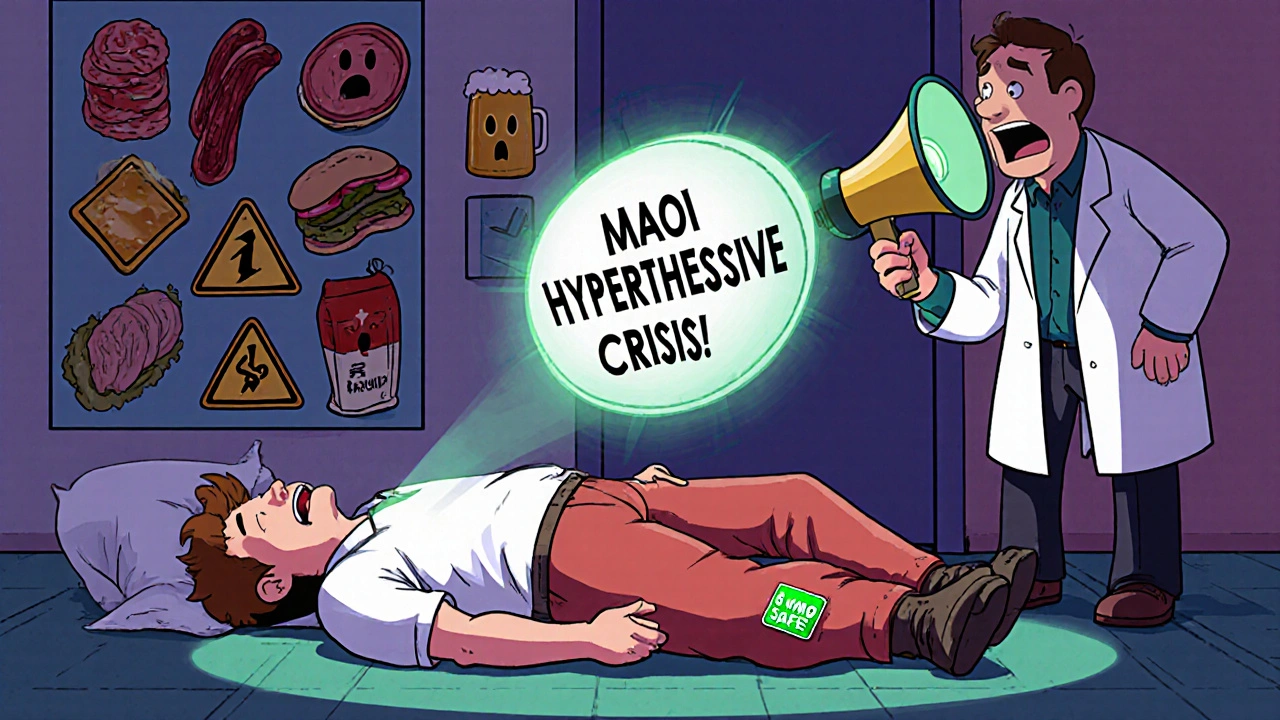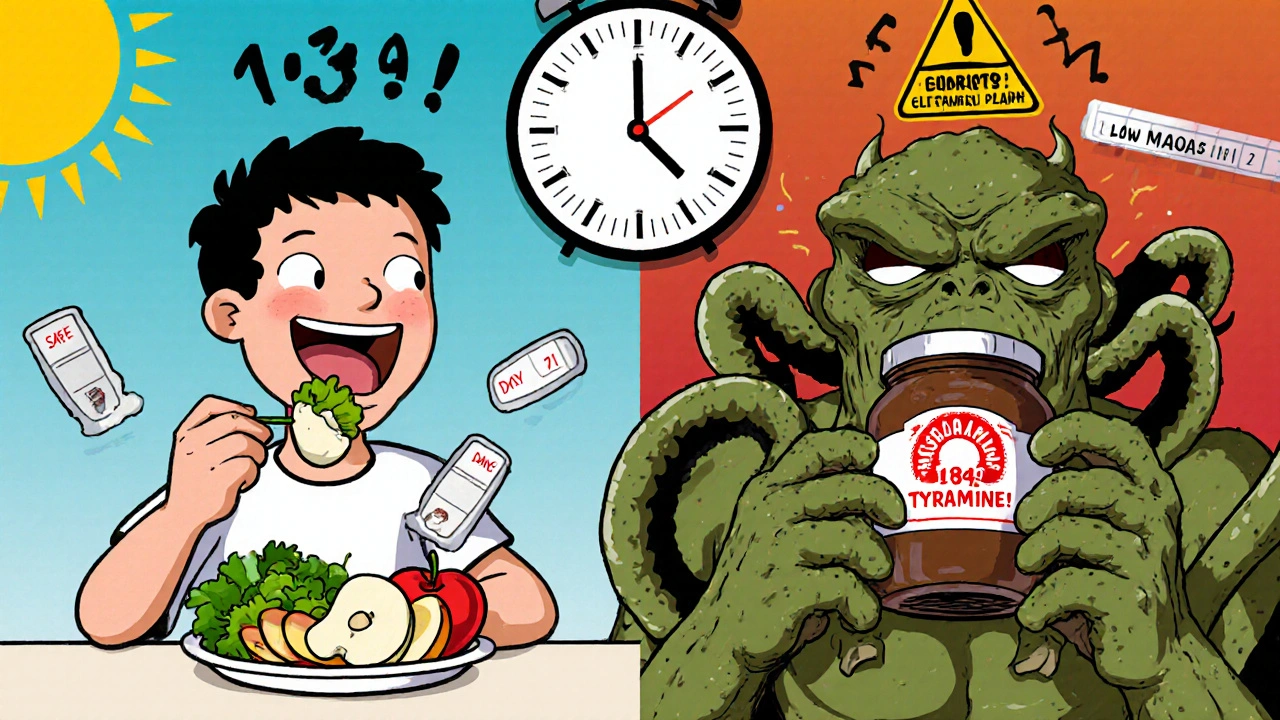 Nov, 17 2025
Nov, 17 2025
MAOI Tyramine Calculator
Tyramine Calculator
Calculate tyramine content in your meals to avoid dangerous blood pressure spikes. The safe threshold is 25 mg in one sitting. (Based on 2023 FDA guidelines)
When you're on an MAOI antidepressant, food isn't just about nutrition-it can be a silent threat. Monoamine oxidase inhibitors like phenelzine, tranylcypromine, and isocarboxazid work differently than SSRIs or SNRIs. They stop your body from breaking down excess tyramine, a compound naturally found in aged, fermented, or spoiled foods. If tyramine builds up, it can spike your blood pressure to dangerous levels-sometimes over 180 mmHg-in minutes. This isn't a theoretical risk. In 1964, a patient taking phenelzine had a stroke after eating cheddar cheese. Today, that same cheese, if properly stored, might be safe. But the confusion around what’s dangerous still puts lives at risk.
Why Tyramine Is Dangerous on MAOIs
MAOIs block the enzyme monoamine oxidase-A, which normally cleans up tyramine in your gut and liver. Without it, tyramine floods your bloodstream, forcing your body to release huge amounts of norepinephrine. That’s what causes the spike in blood pressure, pounding headache, rapid heartbeat, and sweating. In severe cases, it leads to stroke, heart attack, or death. The risk isn’t from eating one wrong thing-it’s from hitting a threshold. Most reactions happen when someone eats more than 25 mg of tyramine in one sitting. That’s roughly the amount in 200 grams of very aged cheese or half a pound of improperly stored meat.
But here’s the twist: not all aged foods are equal anymore. Thanks to better refrigeration and shorter aging times, modern food production has cut tyramine levels dramatically. A 1950s wheel of cheddar might have had 100 mg per 100g. Today’s commercial cheddar? Just 0.1-1.0 mg per 100g. That’s why many old warnings are outdated. Still, some foods remain risky-and knowing which ones matters more than ever.
High-Tyramine Foods to Avoid
Some foods still pack a dangerous punch. These are the ones you need to avoid completely:
- Aged cheeses: Cheddar, blue, brie, camembert, parmesan, gouda-if it’s been aged over 6 months, skip it. Even a small slice (50g) can have over 20 mg of tyramine.
- Tap beer and unpasteurized beer: Draft beer contains live yeast that produces tyramine. One 330ml serving can have 5-18 mg. Bottled pasteurized beer is safer, but still limit to one per week.
- Dry fermented sausages: Salami, pepperoni, chorizo. These can have 25-150 mg per 100g. Even a few slices can push you over the limit.
- Improperly stored fish or meat: If it’s been sitting in the fridge for more than 48 hours, toss it. Fish stored at warm temperatures can hit 200 mg per 100g. Freshly cooked fish, eaten the same day, is fine.
- Soy sauce and miso: Soy sauce can range from 10-118 mg per 100g. Avoid it entirely. Miso paste is also high-skip it unless it’s fresh and refrigerated for less than 24 hours.
- Overripe bananas and avocados: The pulp of a fresh banana is safe (under 1 mg per fruit). But if it’s brown and mushy, tyramine spikes. Same with avocados-eat them when they’re just ripe.
And yes, chocolate is okay-but only up to 30 grams. Dark chocolate has more tyramine than milk, so stick to small portions. Coffee? Fine. Tea? Fine. Fresh fruits and vegetables? Almost all safe. Even tofu, if it’s fresh and under 100g, is generally acceptable.
What’s Actually Safe Now
Modern food science has cleared up a lot of myths. You don’t need to give up everything. Here’s what you can still enjoy:
- Fresh cheeses: Cottage cheese, ricotta, cream cheese, mozzarella (if eaten within 2 days of opening).
- Fresh meats and poultry: Cooked and eaten the same day. Leftovers? Avoid them for the first 4 weeks.
- Fresh fish: Salmon, cod, tuna-just make sure it’s been refrigerated at or below 4°C since purchase.
- Fruits: Bananas (fresh pulp only), apples, oranges, berries, melons. No overripe fruit.
- Vegetables: All fresh or frozen. No fermented pickles or sauerkraut.
- Non-alcoholic drinks: Soda, juice, water, decaf coffee.
One study found that chicken liver stored at 10°C for 72 hours had over 128 mg of tyramine per 100g. The same liver stored at 4°C for 48 hours had just 15 mg. That’s why temperature matters as much as age. Always check your fridge. If it’s above 4°C, food spoils faster-and tyramine builds up.

Your Personal Safety Plan
Knowing what to avoid isn’t enough. You need a system.
- Keep a food diary for the first 7 days. Write down everything you eat and drink. Note your blood pressure before and 2 hours after meals. This helps you spot your personal triggers.
- Use a home blood pressure monitor. Buy one that’s validated for accuracy. Check it daily, especially after meals. If your systolic pressure hits 180 mmHg or higher, act immediately.
- Carry an MAOI ID card. It should list your medication, your doctor’s contact, and the emergency protocol. Many ER staff don’t know about MAOI reactions-this saves time.
- Never eat leftovers during the first 4 weeks. After that, if you reheat food, do it to steaming hot and eat it right away. Store leftovers at 4°C or below and consume within 24 hours.
- Limit high-risk foods. If you want cheese, stick to 150g every 3 days. One glass of wine? Maybe. Two? No. One serving of soy sauce? Avoid it. Two servings? Deadly.
Some patients do fine with minor slip-ups. Others react to a single bite. There’s no way to know until you test it. That’s why caution isn’t optional-it’s life-saving.
What About the Emsam Patch?
If you’re on the transdermal selegiline patch (Emsam), your restrictions are lighter-at least at lower doses. The 6 mg/24 hour patch doesn’t block MAO-A in your gut the same way oral MAOIs do. That means you can eat most foods without risk. But if you’re on the 9 mg or 12 mg patch, you’re back to full restrictions. Always check your dose. And never assume you’re safe just because you’re on a patch.

What to Do in an Emergency
If your blood pressure spikes above 180 mmHg, don’t wait. Don’t call your doctor first. Don’t try to sleep it off.
Take 0.2-0.4 mg of sublingual nifedipine immediately. It’s a fast-acting blood pressure reducer. Keep it in your medicine cabinet. Ask your doctor for a prescription. Then, call 911 or go to the ER. Tell them you’re on an MAOI and suspect a tyramine reaction. Don’t say “high blood pressure.” Say “MAOI-induced hypertensive crisis.” That gets you faster help.
Don’t rely on your symptoms. Some people feel fine until they collapse. Blood pressure is the only reliable sign.
After Stopping MAOIs
You can’t just stop and go back to your old diet. Monoamine oxidase enzymes take 2-3 weeks to regenerate after you stop an irreversible MAOI. That means your body still can’t handle tyramine. Wait at least 14 days-preferably 21-before eating aged cheese, beer, or fermented meats. If you start another antidepressant, check for interactions. SSRIs and SNRIs can also cause dangerous reactions if taken too soon after MAOIs.
What’s Changing in 2025
The old “no cheese, no beer, no meat” rule is fading. A 2023 consensus from 17 global experts says dietary plans should be personalized. The USDA now tracks tyramine levels in over 500 foods. You can find data on fresh vs. aged cheese, soy products, and even specific brands. Some clinics now use genetic testing to see if you have a low-activity MAOA gene. People with this variant have much stronger reactions to tyramine. If you’re on an MAOI and have a family history of high blood pressure, ask your doctor about testing.
Meanwhile, newer drugs like moclobemide (available outside the U.S.) are reversible MAO-A inhibitors. They let your body clear tyramine naturally, so you don’t need strict diets. They’re not yet approved in the U.S., but they’re a sign of where the field is heading.
For now, if you’re on phenelzine, tranylcypromine, or isocarboxazid, treat food like medicine. Know what’s safe. Know what’s not. And never underestimate the power of a single bite.
Can I eat cheese on MAOIs?
Only fresh cheeses like cottage cheese, ricotta, or mozzarella, eaten within 2 days of opening. Avoid aged cheeses like cheddar, blue, or parmesan-they can contain over 20 mg of tyramine per serving. Even a small slice can trigger a dangerous blood pressure spike.
Is beer safe with MAOIs?
Tap beer and unpasteurized beer are not safe-they can have 5-35 mg of tyramine per serving. Bottled pasteurized beer is lower risk, but limit it to one 330ml serving per week. Avoid all craft beers unless labeled as pasteurized and low-tyramine.
Can I have chocolate on MAOIs?
Yes, but only up to 30 grams per day. Dark chocolate has more tyramine than milk chocolate. Avoid chocolate with added nuts, dried fruit, or alcohol. Stick to plain, small portions.
How long do I need to follow the MAOI diet?
You must follow the diet during treatment and for at least 14-21 days after stopping. Monoamine oxidase enzymes take 2-3 weeks to fully regenerate. Eating high-tyramine foods too soon after stopping can still cause a hypertensive crisis.
What should I do if my blood pressure spikes?
If your systolic blood pressure reaches 180 mmHg or higher, take 0.2-0.4 mg of sublingual nifedipine immediately. Then call emergency services. Do not wait. Tell them you’re on an MAOI and suspect a tyramine reaction. This speeds up treatment and saves lives.
Are bananas safe on MAOIs?
Yes, but only if they’re fresh and yellow. The pulp of a ripe banana has less than 1 mg of tyramine. Avoid brown, mushy, or overripe bananas-they contain much higher levels. Peel and eat them right away.
Can I eat soy sauce on MAOIs?
No. Soy sauce contains 10-118 mg of tyramine per 100g. Even a teaspoon can push you over the safe limit. Avoid all soy sauce, teriyaki sauce, and miso paste. Use fresh herbs, lemon juice, or salt for flavor instead.
Is the Emsam patch safer than oral MAOIs?
At the 6 mg/24 hour dose, yes-most foods are safe because it doesn’t block gut MAO-A. But at 9 mg or 12 mg, you’re back to full restrictions. Always confirm your dose with your doctor and never assume you’re safe without checking.
Do I need to avoid all leftovers?
For the first 4 weeks, yes. Tyramine builds up in food over time-even in the fridge. After that, you can reheat leftovers to steaming hot and eat them immediately, but only if stored at 4°C or below and consumed within 24 hours.
What if I accidentally eat something risky?
Check your blood pressure right away. If it’s under 160 mmHg, monitor for the next 2 hours. If it rises above 180 mmHg, take nifedipine and call emergency services. Don’t wait for symptoms. Many people feel fine until it’s too late.
